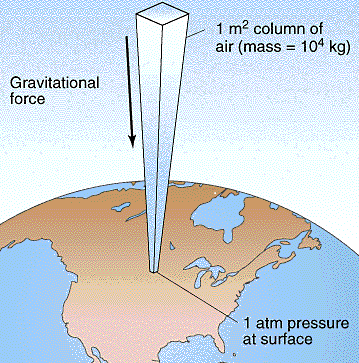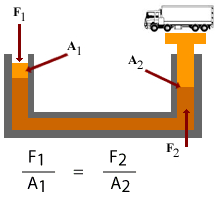Thrust
The total force acting normal (perpendicular) to any given area is called as Thrust
Pressure
When a force acts perpendicularly on a surface and is uniformly distributed over an area A of the surface, then the pressure on the points over the area is defined as
P = Thrust / Area OR Total Force / Area
Hence, pressure is the force acting perpendicularly on a unit area of the object.
Unit of Pressure
SI unit of pressure is Newton/metre2 (N/m2)
Newton/metre2 is also called Pascal (Pa)
1N/m2 = 1Pa
The bar is a non-SI unit of pressure, defined by the IUPAC as exactly equal to 100,000 Pa
i.e. 1 bar = 105 Pa
Also Check: Force
Ques: A force 20 N acts over an area of 4 cm2. Find the value of pressure (in N/m2)?
Solution:
Pressure = Force / Area
Given F = 20 N and A = 4 cm2
Pressure = 20 / 4 x 10-4
= 5 x 10-4 N/m2
Atmospheric Pressure
The pressure at any place due to atmosphere is called atmospheric pressure. Its value varies from place to place. The value of atmospheric pressure at the earth’s surface near the sea level is approximately 1.01 x 105 Pa, which is also known as 1 atmospheric pressure (atm). Thus atm is the unit of pressure
.
1 atm is similar to the pressure that 104 kgf of weight of atmosphere above us will exert on
1 m2 of land. Also, 1 atm = pressure exerted by a mercury column of length 760 mm.
Pressure in a Liquid
A liquid exerts pressure on the base of the container due to its weight and on the walls due to collisions of its molecules with the wall. The magnitude of the pressure exerted by a liquid on a surface inside it does not depend on how the surface is tilted. Surface is horizontal, vertical or at any angle, the pressure has the same magnitude. There are four important rules regarding pressure in a liquid

Pressure at different level can be compared with the speed of liquid flowing out.
- The pressure in a liquid is the same at all the points at the same horizontal level.
- The pressure increases with depth.
- The pressure depends on the density of the liquid.
- The liquid exerts lateral pressure on the walls of the container.
Also Check: Fictional Force
Measurement of liquid pressure
Pressure in liquid can be measured by a simple device called a manometer. A manometer consists of a U shaped tube containing liquid. One arm of the tube is open to air and other arm is connected to funnel with a rubber membrane stretched across its mouth. The difference in pressure in the liquid levels in the two arms represents the pressure exerted on the rubber membrane.
Pascal’s Law
In a fluid at rest, the pressure applied at any one point in the enclosed liquid is transmitted equally in all direction.

Application of Pascal’s Law
Pascal’s principle is used in hydraulic brakes, hydraulic elevators, hydraulic press, hydraulic jacks, vacuum pumps and air compressors.
In all these devices, the pressure on the fluid in them is increased at one point and the fluid carries the pressure increase to all other points on the machine.
- Hydraulic brakes: The force applied to the brake pedal is transmitted to the wheels by a brake fluid.
- Hydraulic press: It consists of a cylinder that contains two pistons, one smaller than the other. The cylinder is filled with a fluid.
A force applied to the smaller piston is transferred through the fluid to the larger piston.
The force increases in direct proportion to the ratio of the area of the larger piston to the area of the smaller piston.
Ques: In a hydraulic lift a force of 5 N applied to one piston of cross-section area in 1 m2. If the cross section of the other piston is 5 m2, find the force on this piston.
Solution: F1 = 5 N, A1 = 1 m2, A2 = 5m2, F2= ?
As we know,
F1 / A1 = F2 / A2
F2 = F1 /A1 x A2
= 5N x 5m2 / 1m2
= 25N
Frequently Asked Questions
Thrust is the force that pushes or pulls an object. For example, when an airplane moves forward, the engines create thrust to overcome air resistance (drag) and gravity.
Pressure is the force applied to an area. It's like how you press down on something. The more force you apply over a smaller area, the greater the pressure.
A pascal is a unit used to measure pressure. It's the pressure created by a force of one newton acting on an area of one square meter.
Related Links
| S.no | Formulas List |
|---|---|
| 1. | Force |
| 2. | Frictional Force |
| 3. | Thrust and Pressure |
| 4. | Buoyant Force |
| 5. | Waves |
| 6. | Sound |
| 7. | Some Natural Phenomena |
| 8. | Electroscope |
| 9. | Lightning |
| 10. | Earthquake |